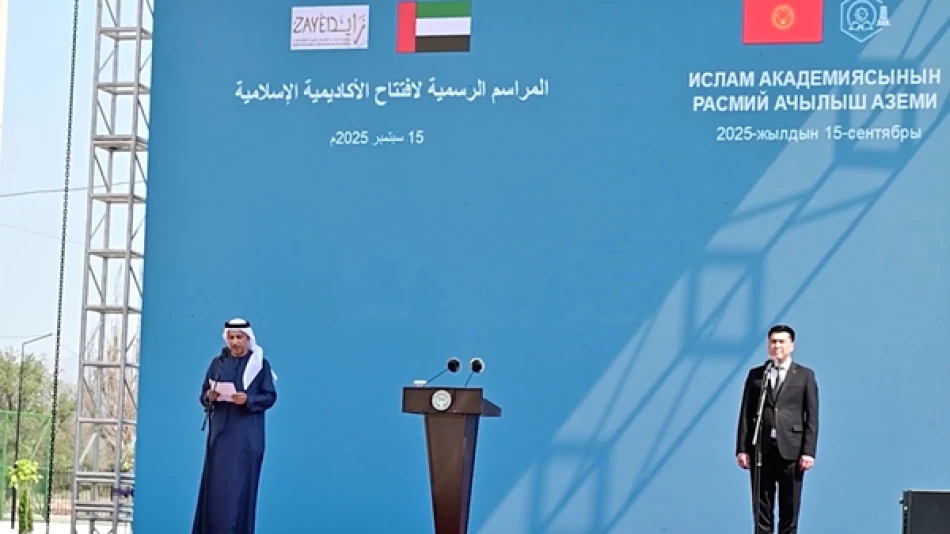
UAE Unveils Islamic Academy in Kyrgyzstan Under Presidential Directive
UAE Opens $5 Million Islamic Academy in Kyrgyzstan, Deepening Central Asian Education Ties
The United Arab Emirates has inaugurated a new Islamic Academy in Kyrgyzstan's Tokmok city, marking a significant expansion of Gulf educational diplomacy into Central Asia. The $5 million facility represents the UAE's growing soft power strategy in the region, offering free higher education and religious studies to Kyrgyz youth while strengthening bilateral ties through educational infrastructure investment.
Strategic Educational Investment in Central Asia
The academy's opening on Monday, attended by Kyrgyz President Sadyr Japarov, follows direct instructions from UAE President Sheikh Mohamed bin Zayed Al Nahyan. Located 60 kilometers from the Kyrgyz capital, the facility features 10 multipurpose classrooms and will offer both undergraduate and graduate programs alongside professional training and continuing education.
This initiative reflects the UAE's broader humanitarian and development strategy, supervised by Sheikh Mansour bin Zayed Al Nahyan and Sheikh Dhiyab bin Mohamed bin Zayed Al Nahyan. The project falls under the Zayed Foundation for Humanitarian Work's global education portfolio, which has been building schools and universities while providing scholarships across developing nations.
Beyond Traditional Diplomacy
The academy represents more than educational aid—it's a calculated move to establish long-term cultural and political influence in Central Asia. Unlike traditional diplomatic approaches, educational infrastructure creates lasting relationships that span generations, potentially opening doors for future economic partnerships and strategic cooperation.
Regional Context and Geopolitical Implications
The UAE's educational expansion into Kyrgyzstan comes amid intensifying competition for influence in Central Asia. While Russia maintains historical ties and China advances its Belt and Road Initiative, Gulf states are carving out their own sphere through targeted investments in education and infrastructure.
This approach mirrors successful UAE strategies in other regions, including Southeast Asia and Africa, where educational partnerships have preceded significant trade relationships. The focus on Islamic education particularly resonates in Kyrgyzstan, where approximately 90% of the population identifies as Muslim.
Filling Educational Gaps
Kyrgyzstan's higher education system faces chronic underfunding and limited capacity, making foreign educational investments particularly valuable. The academy addresses specific needs in religious education, where proper Islamic instruction has been lacking since the Soviet era's secular policies.
Economic and Social Impact
The academy's free tuition model removes financial barriers for Kyrgyz students, while its curriculum promises to produce teachers and religious leaders equipped with modern educational approaches. Deputy Minister of Higher Education Qonurlaan Umurov emphasized the academy's role in training teachers and researchers who will serve in government institutions.
Academy Director Armamat Irgishov highlighted the facility's potential to modernize religious education standards while maintaining authentic Islamic teachings. Graduates will serve as school teachers and mosque imams, creating a multiplier effect throughout Kyrgyz society.
Investment Returns and Future Prospects
For the UAE, the $5 million investment represents exceptional value in diplomatic terms. Educational partnerships typically generate decades of goodwill and create networks of UAE-educated professionals who often maintain favorable views toward their host country throughout their careers.
Broader Implications for Gulf Education Diplomacy
The Kyrgyzstan academy fits within the UAE's systematic approach to education diplomacy, following the humanitarian philosophy of the late Sheikh Zayed bin Sultan Al Nahyan. This strategy has proven effective in building soft power influence across multiple continents.
The emphasis on Islamic values, intellectual dialogue, cultural exchange, and human tolerance positions the UAE as a moderate voice in Islamic education, potentially countering more radical influences in the region. This approach aligns with the UAE's broader foreign policy goals of promoting stability and moderate governance.
Measuring Success
The academy's success will ultimately be measured by its graduates' impact on Kyrgyz society and the strength of UAE-Kyrgyzstan relations in coming decades. Early indicators suggest strong local enthusiasm, with high enrollment numbers and positive reception from both government officials and faculty members.
As Central Asian nations seek to diversify their international partnerships beyond traditional Russian and Chinese influence, the UAE's educational diplomacy offers an attractive alternative that combines practical benefits with cultural compatibility. The Islamic Academy in Tokmok may well serve as a model for similar initiatives across the region.
Most Viewed News

 Layla Al Mansoori
Layla Al Mansoori






